The auction series, formerly known as Westlicht (West Light), the Leitz Photographic auction series continues seamlessly under the new management of Leica Camera. It is held biannually in June and November, with the location swapping between its original home in Vienna and Wetzlar. On the twelve of June, we will see the 38th Leitz Photographica event featuring primarily Leitz equipment, plus a wide range of quality makes and historically interesting cameras and equipment.
I have been participating in this auction for some nine years and have won items at about 17 auctions in that time. The only one where I did not buy was the one I attended in Wetzlar in 2014 for the opening of the new Leica HQ.
This article sets out some of the highlights of the forthcoming auction. Most of these items will fetch very high prices and will be beyond the reach of most readers here, myself included, but these cameras all have interesting stories attached to them, which have mainly influenced my choice of lots for this article.
Wait, a Moment
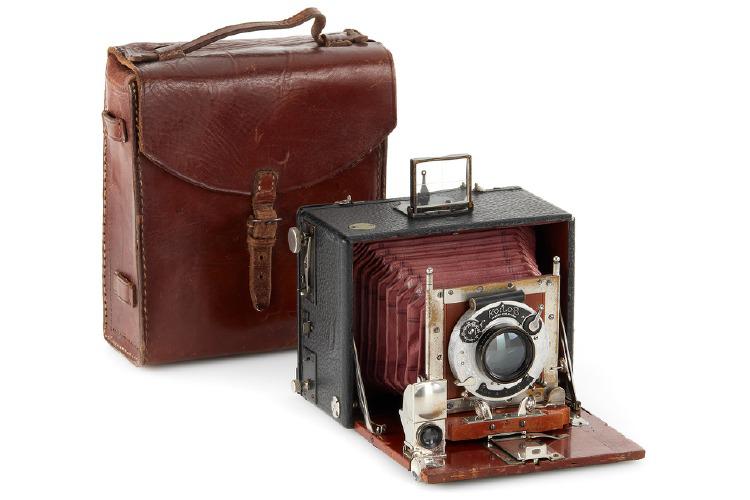
This camera (Catalogue No 1) is a Leitz Moment camera from around 1905, 20 years before the first commercially available Leica cameras appeared. This is a view camera in 9×12 cm format with a matching Leitz Summar f/4.5 12 cm lens in a Koilos shutter. I actually have an example of that lens in my collection.
In later years the lens was used for macro work, but earlier it was popular for general photography. Every Moment camera I have seen looks different, except for the lenses. It has been surmised that Leitz put these together with cameras from other manufacturers such as Ernemann or Kreugener.
They were intended to be sold by the Leitz firm through its dealer network, and different plates and badges appear on the cameras to indicate the dealer involved. The camera was not a great sales success and very few of these highly individualistic cameras have survived. I know of only a handful of such cameras, perhaps as few as four or five.
As a result, the Leitz Moment camera fetches very high prices when examples come up for auction. This one has a start price of €20,000 with an estimate in the range of €40,000 to 50,000. Based on the last two examples which came up for auction, this range seems just right for such a rare piece.
The man himself
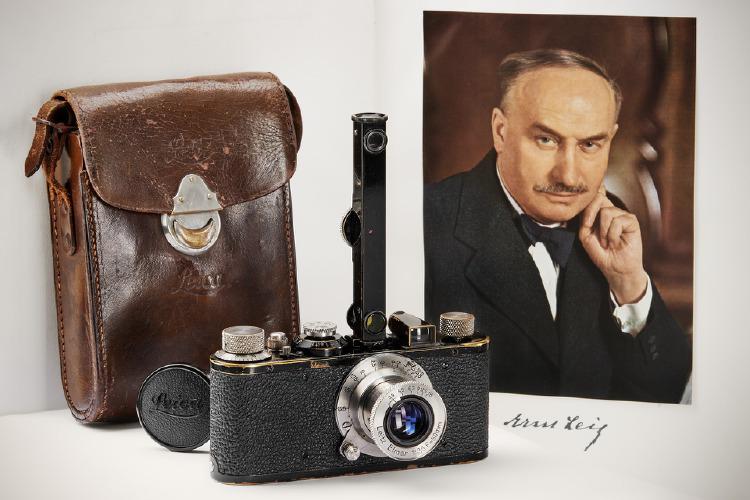
Number 6 in the catalogue, this Leica I Model A serial number 165, was the personal camera of Ernst Leitz II. There can’t be much more of a more compelling provenance than this.
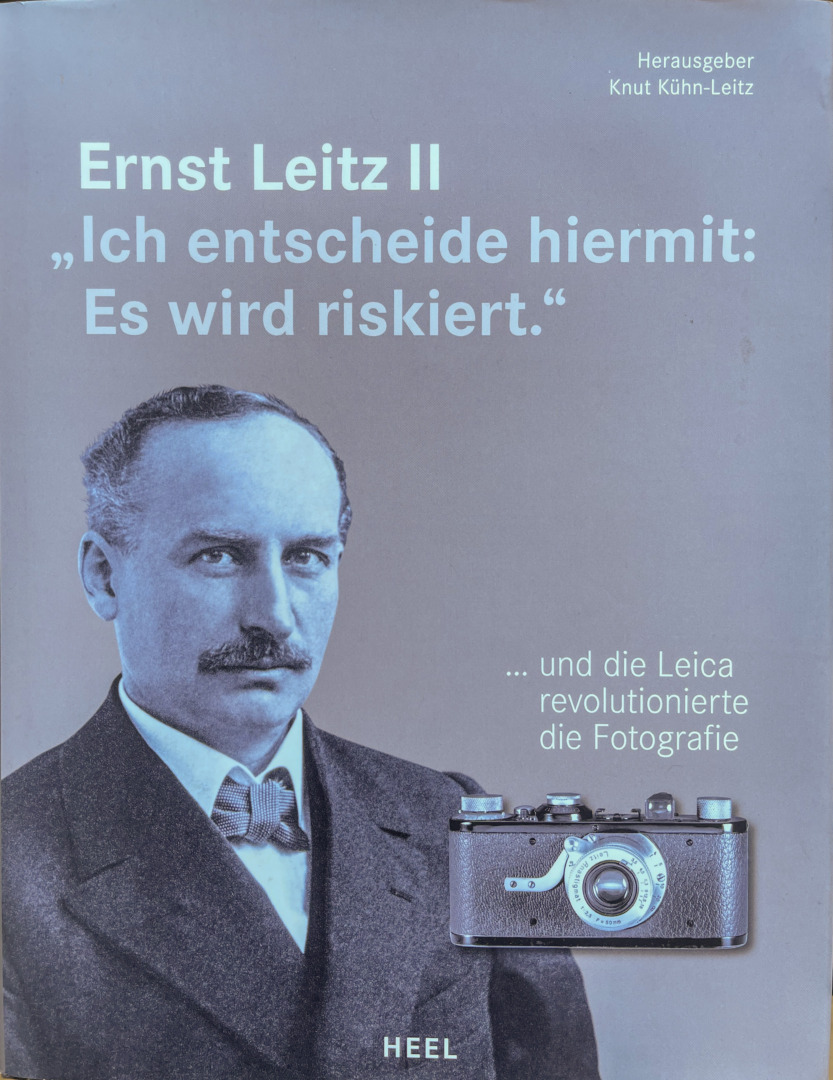
Extensive research in the Leica archives revealed that the Leica was delivered on 24 December 1924 to Ernst Leitz Jr. We could speculate that it may have been a Christmas gift. A closer inspection of the page from the delivery book reveals that the initial date is written on the top of the page, ‘1924’, has been later changed to 1925.
Camera No.165 is the only one from the batch delivered in December; all the others have been delivered in February or June 1925. This may indicate that it was the first Leica I Mod. A, delivered at the end of 1924.
Factory service records show that the camera was in the workshop on three occasions and was upgraded several times to the final form we can see now. It comes with an unnumbered nickel Elmar 3.5/50mm (coated optics), unnumbered FODIS rangefinder, two film spools and an ETRIN case.
According to the Leica archives, the only other camera of such significance was the Leica 0-Series no.102 that was also given to Ernst Leitz Junior. This Leica is the only camera ever offered for sale that belonged to the man who, in 1923, took the bold decision to manufacture the Leica camera.
The start price for this stunning piece of Leica history is a comparatively ‘modest ‘ €40,000 with an estimate in the range €80,000 to €100,000. In this case it is not just about the camera, which is in itself desirable, but also about the provenance. I expect that the estimate will be well exceeded, possibly by a large multiple.
Glitter
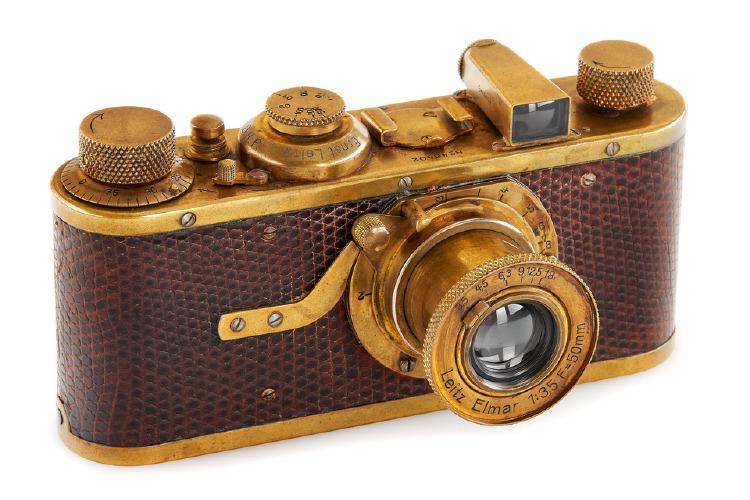
This camera (Catalogue No 12) is, of course, responsible for the title of this article. It is a genuine Leica I Model A Luxus camera, serial number 48402, with gold plating and in original condition. With gold-plated metal parts and a lizard-skin covered body, the camera was never restored and shows the typical light patina.
Only 95 Luxus Leicas were produced from 1929 to 1931. Some were later converted or upgraded, and only a handful of cameras exist in the original condition. This Luxus Leica is one of the major rarities in the Leica world and was delivered to New York in 1930 as LESSALUX (Leica Luxus).
There is already a bid for €100,000 for this camera. The estimated range is €200,000 to €250,000, which is well below the Collectiblend average of auction results. The last one, which sold at Westlicht, went for more than a million euros, including buyer’s premium, in 2012.
Explorer Leica
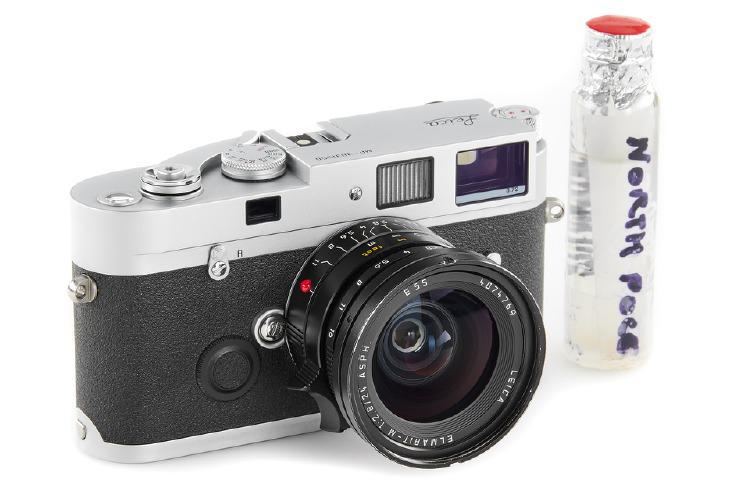
Catalogue No 134 is an interesting film Leica MP from 2010 with serial number 3831550, owned and used by British photographer and Arctic explorer Martin Hartley. It is in excellent condition, with a base plate engraved with the photographer’s name and details of the Arctic Expedition the camera took part in.
The camera comes with Elmarit-M 2.8/24mm no.4074769, MP rewind crank, two prints 55.5x54cm and 56.5x42cm taken with this camera and signed by Hartley, as well as a bottle of clear Arctic water.
I recall an article by Martin at the time of this expedition. He chose the MP over other film cameras and, indeed, any digital camera, as he was concerned about the effects of the low temperatures, particularly regarding battery life. There is a nice article on Martin’s adventures with the camera on the blog site of the Leitz Auction here.
The start price for this camera is €3,000, with an estimate in the range of €6,000-7,000. While this is considerably less than the estimates for the previous cameras, this one is more difficult to call. Much depends on the number of interested bidders on the day of the auction.
Famous Cameras and a Famous Photographer
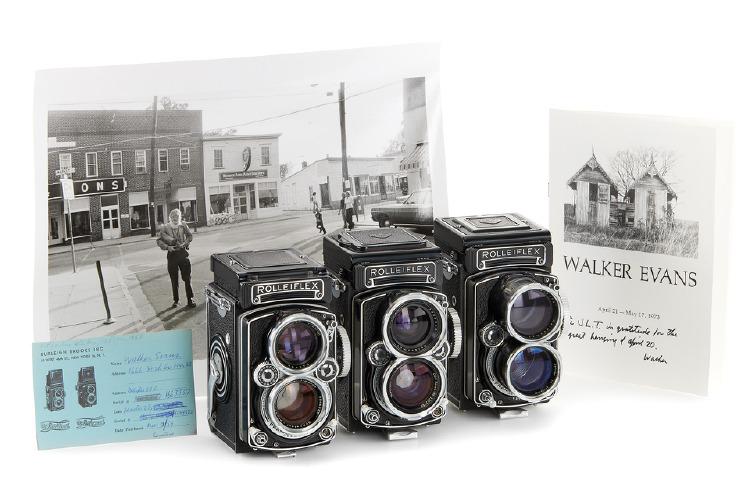
This set (Catalogue No 288) of three Rolleiflex cameras was owned and used by the famous photographer Walker Evans. The outfit includes a Rolleiflex E , No.1663337, a Tele-Rolleiflex No.S2302105 and Rolleiflex Wide, No.W2491107.
Walker Evans used these three cameras until late 1973, when he began to use a Polaroid SX-70 almost exclusively. Though he had other cameras, the Rolleiflexes were the ones he used most often, both for his work for magazines and personal photography. He updated his equipment over the years, and the three Rolleiflexes were among the last ones he owned. A personal and professional assistant of Mr Evans received these cameras as a gift, which confirmed the provenance.
Also included in this lot is a signed vintage 11×14 print by Marcia Due, showing Walker Evans with a Rolleiflex camera in Virginia, 1973. In addition, the package contains an exhibition booklet signed by Evans, a warranty card from 1959 completed by Evans and mentioning the Rolleiflex E.
Walker Evans (1903-1975) was an American photographer and photojournalist. He is widely acknowledged as one of the most important photographers of the twentieth century and worked primarily in the USA. His enormous artistic influence has been recognised, not only there but internationally.
Evans is best known for his work for the Farm Security Administration (FSA), documenting the effects of the Great Depression on the rural population in the Mid 1930s. The portraits of the three families: Fields, Borroughs and Tingle became icons of photographic history through the publication of the book, “Let Us Now Praise Famous Men” with text by James Agee and photographs by Evans.
After 1945, Evans photographed, among other subjects, American urban landscapes and industrial buildings for magazines such as Harper’s Bazaar, Vogue, Architectural Forum, and Life and Fortune. In 1938, the Museum of Modern Art, New York (MoMa) organised its first exhibition of a single photographer for Walker Evans: American Photographs.
Since then, many of his works are in permanent collections of museums or have been the subject of retrospectives at institutions such as the Metropolitan Museum of Art, the George Eastman Museum, the Centre Pompidou, or, most notably at the Museum of Modern Art, New York and the J. Paul Getty Museum in California, USA.
This set of cameras has a starting price of €20,000 with an estimated range of €40,000 to €50,000. The fame of Walker Evans and the provenance are bound to attract a lot of interest from bidders.
Lots more
In this auction, there are 469 lots, covering a wide range of makes and cameras, lenses and accessories, which can be seen here. You can see the full catalogue here.
I have chosen the above cameras as highlights, not only because of their rarity but also because they have interesting provenance or stories attached to them. I have written here before that collecting cameras is not just about getting ‘good cameras’ to use, but rather about collecting a piece of history which these examples admirably illustrate.
Read more by William Fagan
Make a donation to help with our running costs
Did you know that Macfilos is run by five photography enthusiasts based in the UK, USA and Europe? We cover all the substantial costs of running the site, and we do not carry advertising because it spoils readers’ enjoyment. Every amount, however small, will be appreciated, and we will write to acknowledge your generosity.

Thoroughly enjoyed this article William! Fascinating provenance on the items you have selected. I need to win the lotto though! 🙂
Great synopsis of some of the highlights coming up at this auction, William! I, too, would love to own the Hartley as I have an interest in all things Arctic. But, since I purchased an M10-R and a 135mm Apo-Telyt-M last year my Leica budget is standing at ZERO!
Keep up the good work!
Thanks Wilbur. For me the Hartley camera would be the most affordable, but I may not be bidding on that. You may have seen my email earlier to LHSA colleagues where I said that if I was given the choice (for no money) I would take the Moment camera. Then again, it would be nice to own cameras used by Walker Evans. Too many choices and not enough money!
William
Hi William,
Thanks for the article which elaborates on the details in the catalogue.
I will forward this to the man who knows the man with the Moment camera.
the price might surprise him.
Regards
Philip
Thanks Philip and thanks for that book on the Great Melbourne Telescope which was made in the 1860s about 3 miles away from where I live in Dublin by the same Grubb firm mentioned above. Examples of the Moment camera have been sold on two occasions in the last decade and they have sold for the price range given by the auctioneer here. It would be a lovely thing to own if you could afford it, but you would need big insurance or a bank vault, preferably both!
William
Truly enjoyed the article. I would like to hae an M6 but it’s beyond my price range as I collect phtotography books already. These old wooden bodies are really wonderful.
Jean
Thanks Jean. I collect books too, unfortunately. I have come across a new one (largely in German) about Barnack’s right hand man and I might do review of it here. As you may have noticed I find the history of Leica and photography irresistible. I have 3 wooden cameras, probably early 20th Century. Two of them have Irish addresses on their name plates, but I think that only one of them was made here. My oldest camera is a Kemper Kombi which dates to the 1890s, but I have Irish made Grubb brass lenses dating back to the 1850s.
William
I really enjoyed reading your article. Your knowledge is amazing. The only Leica film camera I ever owned was the M4P. I regret selling it when I switched to digital.
Which film M with a meter do you think is the best?
I’d recommend an M6 in good condition without hesitation. They have increased in price in recent years, but everything about the M6 is just right, from the super quiet shutter and the intuitive metering to the placement of the controls.
William
Thank you William for an interesting heads-up into an upcoming world in which passionate people participate.
How many of the 469 lots might catch a bid from you? Are there any items that you will chase for your collection? (Not necessary to nominate which one or two, even if catalogue item #6 is high on your list 😀).
Thanks Wayne. I am mulling about some items. The only one here that would be remotely affordable for me would be the Arctic camera. The others would be way beyond my reach. I’ll let you know when the auction is over.
William